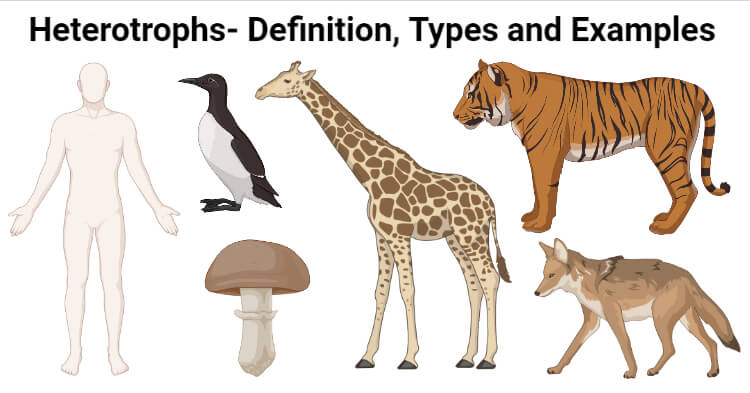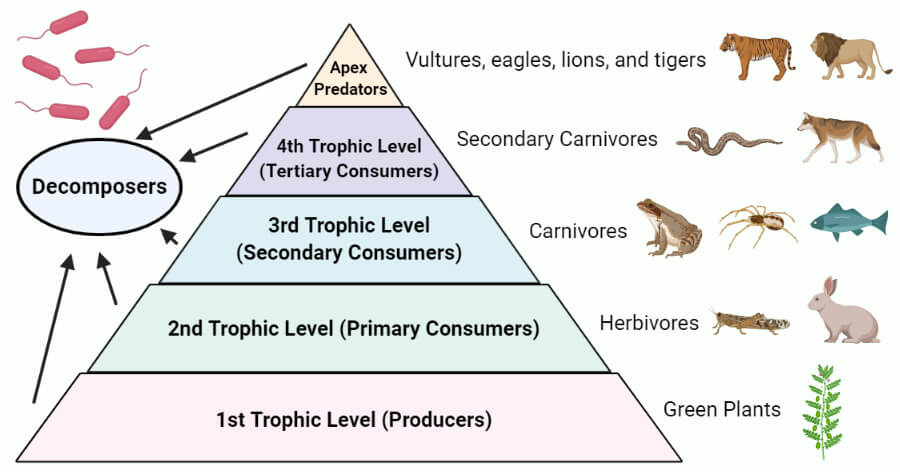Interesting Science Videos
Heterotrophs Definition
Heterotrophs are organisms that do not produce their food and depend on other organisms for their food and energy.
- Heterotrophs are a group of organisms that are distinct from autotrophs that prepare their own food as well as provide food to the heterotrophs.
- The term heterotroph is composed of two words; ‘hetero’ meaning others and ‘troph’ meaning food, indicating that these organisms depend on other organisms for food.
- Heterotrophs are also called consumers in the ecosystem as these consume food prepared by autotrophs and form the higher trophic levels in the food chain.
- Unlike autotrophs, heterotrophs do not have systems for the reduction of carbon sources. These organisms take up the complex biomolecules from the producers and break them down into simpler components with the help of different enzymes.
- Heterotrophs obtain the reduced organic compounds from autotrophs and oxidize them to produce energy.
- Even though most heterotrophs depend on autotrophs for energy as well as food, there are some heterotrophs that acquire energy from solar energy or chemical reactions.
- Heterotrophs are important in the ecosystem as these make up a lot of biomass and are responsible for the transfer of energy and biomass through the food chain.
- Heterotrophs can be classified as different groups of consumers as primary, secondary, and tertiary consumers. Heterotrophs also make up the decomposers in the food chain that feed on the dead and decaying biomass in the environment.
- Different groups of heterotrophs have different complexities and systems that enable them to acquire energy and food from autotrophs.

Types of Heterotrophs based on the energy source
1. Photoheterotrophs
- Photoheterotrophs or heterotrophic phototrophs are a group of living beings that derive their energy from solar energy but depend on autotrophs for food.
- These heterotrophs cannot utilize carbon dioxide as a carbon source and require other organic compounds. These are also known as holozoic organisms.
- These photoheterotrophs utilize systems like electron transport chains or direct proton pumping in order to generate an electrochemical gradient to provide molecular energy.
- Photoheterotrophs can generate ATPs through phosphorylation, but they depend on organic compounds for growth and biomolecules.
- Photoheterotrophy is an important lifestyle for organisms living in areas where growth and survival are limited by the availability of energy-rich niches.
- Most commonly, photoheterotrophs occur in surface water with large populations of living beings. The ability to utilize solar energy to produce energy decreases their dependency on respiration.
- Some of the examples of photoheterotrophs include Heliorestis baculata, H. convulata, and Synechococcus elongatus.
2. Chemoheterotrophs
- Chemoheterotrophs are heterotrophs that obtain their energy from chemical compounds and consume food produced by autotrophs.
- Unlike phototrophs, chemotrophs cannot utilize solar energy and depend on energy obtained from reduced carbon compounds by the process of respiration.
- A particular group of chemoheterotrophs can derive energy from inorganic chemical substances; however, they still require organic compounds to build their biomass and form biomolecules.
- Chemoheterotrophs are the larger group of heterotrophs which includes organisms from all domains.
- Chemoheterotrophs are essential for the normal functioning of an ecosystem as these organisms take up organic materials from plants and other autotrophs and cycle them through the food web.
Types of Heterotrophs based on electron source
1. Organotrophs
- Organotrophs are heterotrophs that utilize organic compounds for energy as well as food.
- These organisms derive energy from the oxidation of organic compounds via internal respiration.
- In organotrophs, the organic compound acts as the source of an electron, which then passes through the electron transport chain to produce ATPs.
- Organotrophs include all animals and some bacteria. The organotrophic bacteria can be aerobic or anaerobic.
2. Lithotrophs
- Lithotrophs are heterotrophs that utilize inorganic compounds or geological processes as their source of electrons.
- The most common inorganic compounds that are used as electron sources include elemental sulfur and elemental gases.
- Most lithotrophs are smaller bacteria as the inorganic compounds do not produce enough energy, like in the case of larger organic sugars.
- These can oxidize electron donors to produce electrons that are then channeled into electron respiratory channels to form ATP.
- The only known lithotropic organisms are unicellular organisms; however, multicellular organisms might obtain energy from symbioses with the unicellular organisms.
- Most lithotrophs are found in areas like sea floors or underground water sources where chemical food sources are found.
Examples of Heterotrophs
1. Fungi
- Fungi are a group of eukaryotes that depend on dead and decaying matter for their food as well as energy.
- Fungi are organoheterotrophic organisms that use complex organic compounds as their electron source.
- Fungi make up the decomposers in the food chain, where they consume dead and decaying organisms and release simpler molecules so that those can be utilized by the autotrophs.
- These are mostly found in dry and arid environments, and these occur in the soil where most dead and decaying components are located.
- There is a large number of fungal species that can be aerobic or anaerobic, and depending on the availability of oxygen, these produce different levels of energy from organic compounds.
2. Photoheterotrophic cyanobacteria
- Photoheterotrophic cyanobacteria are a group of microorganisms that have superior photosynthetic efficiency and minimum growth requirements.
- These bacteria cannot use carbon dioxide as a source of carbon, but they can use solar energy for the transfer of electrons in the electron transport chain.
- The bacteria occur in aquatic or damp environments where they feed on the organic compounds produced by autotrophic aquatic organisms.
- These are increasingly studied due to their ability to produce a large amount of energy in the presence of sunlight.
3. Iron-reducing bacteria
- Iron-reducing bacteria are bacteria that metabolize reduced iron to oxidized iron compounds to produce energy.
- The energy obtained from the process is then utilized for absorption of carbon source and metabolism.
- These bacteria have been proposed to be used for decontamination of metal or metalloid polluted environments.
- Even though iron-reducing organisms are associated with extreme environments, these can occur in other areas as well.
- The occurrence of these bacteria in extreme environments is due to the occurrence of the inorganic compounds in such environments.
4. Animals
- Animals make up the most important group of heterotrophs in the environment as these occupy the maximum number of trophic levels in the food chain.
- All animals are heterotrophic, but their dependency on the autotrophs might differ as some depend on autotrophs while others are indirectly dependent.
- Herbivorous animals feed on autotrophic organisms like plants and phytoplanktons to obtain both energy as well as food.
- Carnivores, in turn, feed on herbivores, indicating an indirect dependency on the autotrophs.
- The organic compounds are taken up by the organisms, which are then broken down into simpler molecules by different mechanisms.
Heterotrophs in the Food Chain
- Heterotrophs are the largest group of living organisms in the food chain, occupying multiple trophic levels.
- The second trophic level is occupied by consumers that directly feed on autotrophs so as to begin the transfer of energy in the system.
- The heterotrophs on the third trophic levels are secondary consumers that feed on primary consumers. These are the more complex group of organisms that feed on organic compounds.
- Decomposers are another important group of organisms residing at the higher trophic levels in the ecosystem. These are an essential group of heterotrophs that feed on dead and decaying materials to release the inorganic compounds back to the environment.
- Each trophic level transfers 10% of the energy while the rest of the energy is stored in the trophic level as biomass.

Important Viva Questions on Heterotrophs
- What are Heterotrophs?
- Define Heterotrophs.
- What are the types of Heterotrophs?
- Write 4 examples of Heterotrophs.
- Where are Heterotrophs in the Food Chain?
References and Sources
- Singh, Vipin & Singh, Asha & Singh, Rishikesh & Kumar, Ajay. (2018). Iron oxidizing bacteria: insights on diversity, mechanism of iron oxidation and role in the management of metal pollution. Environmental Sustainability. 1. 10.1007/s42398-018-0024-0.
- Emerson D, Fleming EJ, McBeth JM. Iron-oxidizing bacteria: an environmental and genomic perspective. Annu Rev Microbiol. 2010;64:561-83. doi: 10.1146/annurev.micro.112408.134208. PMID: 20565252.
- Cockell C.S. (2011) Lithotroph. In: Gargaud M. et al. (eds) Encyclopedia of Astrobiology. Springer, Berlin, Heidelberg. https://doi.org/10.1007/978-3-642-11274-4_903
- https://readbiology.com/heterotroph/ – 5%
- https://microbenotes.com/autotroph-vs-heterotroph/ – 4%
- https://diffzi.com/heterotrophs-vs-autotrophs/ – 4%
- https://www.scienceabc.com/nature/animals/what-are-hetretrophs.html – 3%
- http://www.fao.org/3/t0122e/t0122e03.htm – 1%
- https://biologydictionary.net/chemoheterotroph/ – 1%
- https://en.wikipedia.org/wiki/Phototroph – 1%
- https://www.quora.com/What-are-lithotrophsINTERNET1%https://www.epa.gov/sites/production/files/2019-08/documents/external_carbon_surces_for_nitrogen_removal_fact_sheet_p100il8f.pdf – 1%
- https://microbenotes.com/microorganisms-in-soil/ – <1%
- https://en.wikipedia.org/wiki/Cyanoprokaryote – <1%
- https://quizlet.com/305316982/ch-10-investigation-flash-cards/- <1%
- https://bio.libretexts.org/Bookshelves/Microbiology/Book%3A_Microbiology_(Boundless)/5%3A_Microbial_Metabolism/5.01%3A_Types_of_Metabolism/5.1A%3A_Photoautotrophs_and_Photohetrotrophs – <1%
- https://www.answers.com/Q/Can_fungi_help_in_the_food_chain – <1%
